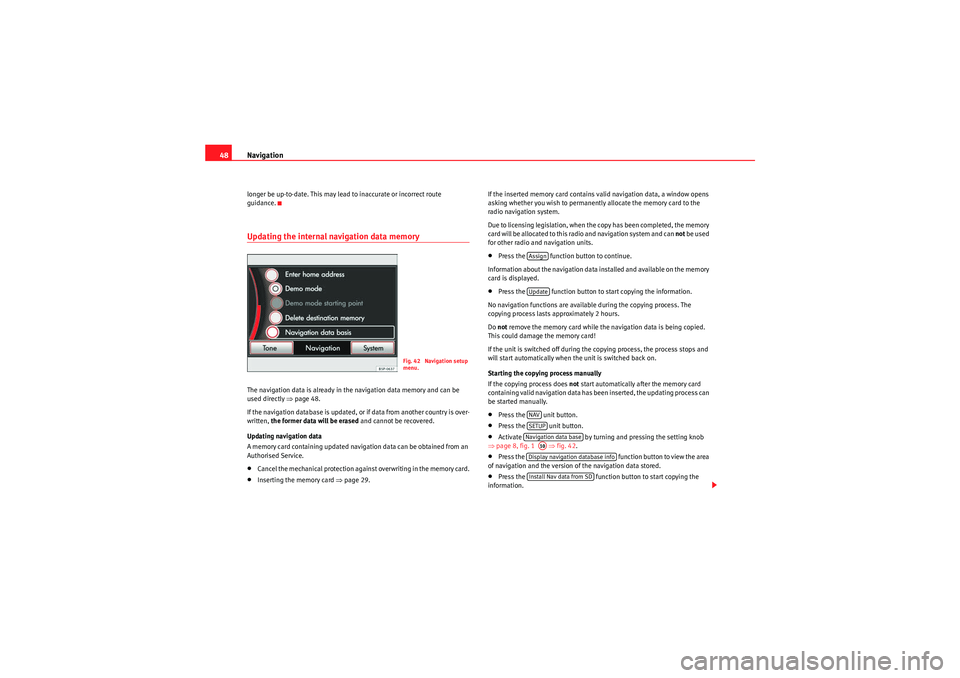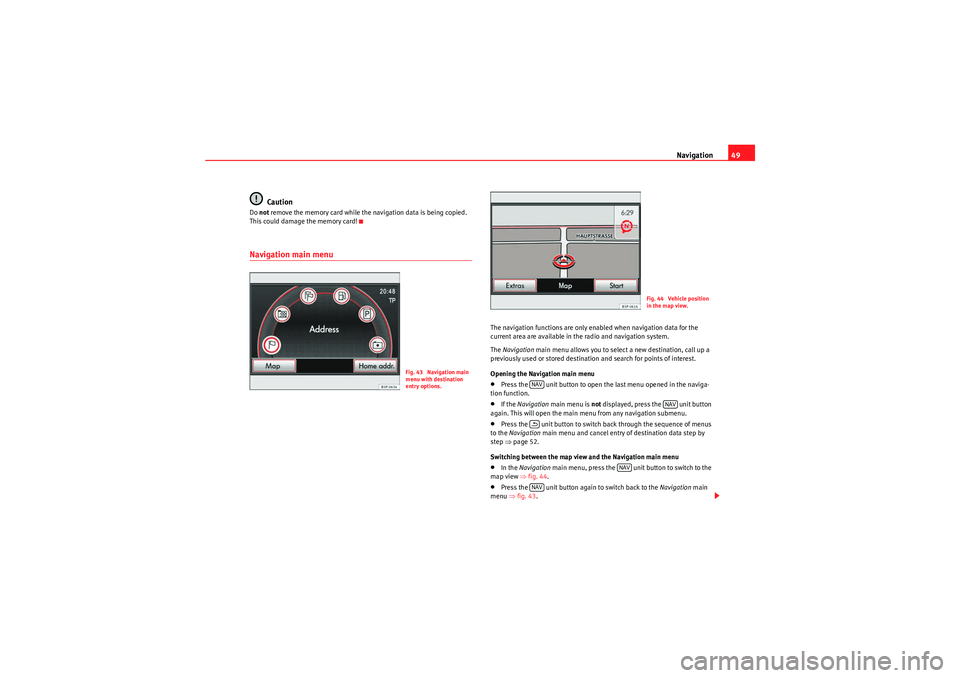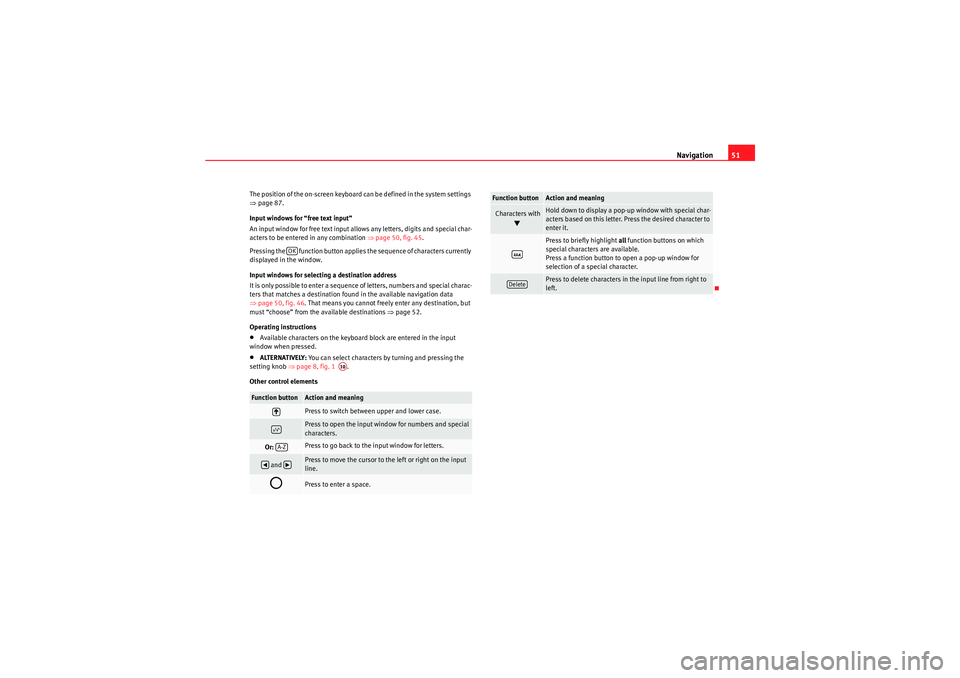2010 Seat Leon 5D navigation system
[x] Cancel search: navigation systemPage 46 of 99

Audio mode45
When should it be activated?•LEON: to play audio from an iPod (via the SEAT adapter cable) or from an
external device connected to the AUX input of the MEDIA-IN interface.•ALTEA, ALTEA XL, Freetrack: to play audio from an external player
connected to the AUX input of the Rear Seat Entertainment system (if fitted in
the vehicle)
iPod® and iPhone
®
When an iPod
® or iPhone
® is connected, a special iPod selection menu is
displayed at the top selection level of the track view ⇒page 43, fig. 41. This
iPod selection menu always has the same structure and is operated in the
familiar way.
The music controls on the connected iPod
® or iPhone
® are disabled.
The output volume of a connected iPod
® or iPhone
® should be adjusted to
the volume of the other audio sources ⇒ page 41.Possible error messages after connecting an external data medium
Note
External audio sources connected to the AUX socket of the MEDIA-IN interface
can be played through the radio and navigation system, but cannot be
controlled from there. To control the external audio source, please see the
manufacturer's instructions. As long as the external audio source is not
switched off, it will continue operating even if another source starts to play in
the radio and navigation system.
Note
The MDI symbol remains visible and on (highlighted in red), and therefore
accessible, as long as the “Activate AUX2 input” check box (Media setup
menu) is ticked. The option should be deactivated when playback has
finished.Error message
Cause
Procedure
Device not
supported
Playback from the
external data medium
or communication via
the adapter cable used
is not possible.
Check adapter cable.
Update the software of the
MEDIA-IN multi-media inter-
face at your Authorised Serv-
ice.
If possible, update the soft-
ware of the external data
medium.
Unit not ready for
operation
Communication inter-
rupted.
Check the connection and
make sure the external data
medium is working correctly.
Due to the large number of different data media and various iPod
® and
iPhone
® generations available, it is not possible to guarantee fault-free
operation of all functions described here.
MediaSystem2.1_EN.book Seite 45 Donnerstag, 29. April 2010 4:18 16
Page 48 of 99

Navigation47
NavigationIntroduction to navigationIntroductionGeneral information
The current vehicle position is determined by means of the GPS system
(Global Positioning System). Sensors in the vehicle measure distances
driven. The measurements are adapted using the detailed information given
in the navigation data medium ma ps and according to the programmed
traffic management. Where applicable, TMC traffic reports are included in the
calculation of routes ⇒ page 70. The navigation system uses these data to
determine an optimal route to the destination.
The destination is defined by entering an address or a point of interest, e.g.
apetrol station or hotel.
Navigation announcements and visual guidance on the navigation unit and
the instrument panel direct you to your destination ⇒page 63.
Depending on the country, some radio-navigation system functions can no
longer be selected when the vehicle is travelling above a certain speed. This
is not a malfunction, but simply a legal requirement.
Navigation data
In normal circumstances, all the necessary navigation data is already stored
in the navigator. A memory card containing the navigation data can be
obtained from an Authorised Service to update this information ⇒page 48.
Additional Information:•Safety notes
�’ ⇒ page 6
•Unit overview ⇒ page 8•Entering a destination ⇒page 52
•Destination memory ⇒page 58•Route guidance ⇒ page 63Note
Dirty or damaged navigation data media may lead to problems when copying
navigation information or even in the navigation itself. Store unused data
media in a suitable container or in the original box to protect them from
mechanical damage, heat, humidity or direct sunlight.Limitations of the navigation functionPossible errors in navigation
If the navigation system is not able to receive data from the GPS satellites
(dense vegetation, underground garage), it is still possible to navigate using
the vehicle sensory analysis.
In areas that are not or only partially digitised on the data medium
(e.g. insufficient definition of one-way streets and road categories), the navi-
gation system will still attempt to provide route guidance.
If navigation data are unavailable or incomplete, the navigation system may
be unable to determine the exact vehicle position. As a result, the navigation
may not be as exact as usual.
Navigation area and age of navigation data
The accuracy of the data (small villages, streets and house numbers)
depends on the respective version for the country.
Roads and streets are subject to constant change (e.g. new roads, changes to
street names and house numbers). After some time, navigation data will no
MediaSystem2.1_EN.book Seite 47 Donnerstag, 29. April 2010 4:18 16
Page 49 of 99

Navigation
48longer be up-to-date. This may lead to inaccurate or incorrect route
guidance.Updating the internal navigation data memoryThe navigation data is already in the navigation data memory and can be
used directly ⇒page 48.
If the navigation database is updated, or if data from another country is over-
written, the former data will be erased and cannot be recovered.
Updating navigation data
A memory card containing updated navigation data can be obtained from an
Authorised Service.•Cancel the mechanical protection against overwriting in the memory card.•Inserting the memory card ⇒page 29. If the inserted memory card contains valid navigation data, a window opens
asking whether you wish to permanently allocate the memory card to the
radio navigation system.
Due to licensing legislation, when the copy has been completed, the memory
card will be allocated to this radio and navigation system and can
not be used
for other radio and navigation units.
•Press the function button to continue.
Information about the navigation data installed and available on the memory
card is displayed.•Press the function button to start copying the information.
No navigation functions are available during the copying process. The
copying process lasts approximately 2 hours.
Do not remove the memory card while the navigation data is being copied.
This could damage the memory card!
If the unit is switched off during the copying process, the process stops and
will start automatically when the unit is switched back on.
Starting the copying process manually
If the copying process does not start automatically after the memory card
containing valid navigation data has been inserted, the updating process can
be started manually.•Press the unit button.•Press the unit button.•Activate by turning and pressing the setting knob
⇒ page 8, fig. 1 ⇒ fig. 42.•Press the function button to view the area
of navigation and the version of the navigation data stored.•Press the function button to start copying the
information.
Fig. 42 Navigation setup
menu.
AssignUpdateNAVSETUPNavigation data base
A10Display navigation database infoInstall Nav data from SD
MediaSystem2.1_EN.book Seite 48 Donnerstag, 29. April 2010 4:18 16
Page 50 of 99

Navigation49
Caution
Do not remove the memory card while the navigation data is being copied.
This could damage the memory card!Navigation main menu
The navigation functions are only enabled when navigation data for the
current area are available in the radio and navigation system.
The Navigation main menu allows you to select a new destination, call up a
previously used or stored destination and search for points of interest.
Opening the Navigation main menu•Press the unit button to open the last menu opened in the naviga-
tion function.•If the Navigation main menu is not displayed, press the unit button
again. This will open the main menu from any navigation submenu.•Press the unit button to switch back through the sequence of menus
to the Navigation main menu and cancel entry of destination data step by
step ⇒page 52.
Switching between the map view and the Navigation main menu•In the Navigation main menu, press the unit button to switch to the
map view ⇒fig. 44 .•Press the unit button again to switch back to the Navigation main
menu ⇒fig. 43.
Fig. 43 Navigation main
menu with destination
entry options.
Fig. 44 Vehicle position
in the map view.
NAV
NAV
�E
NAV
NAV
MediaSystem2.1_EN.book Seite 49 Donnerstag, 29. April 2010 4:18 16
Page 51 of 99

Navigation
50Selecting destination entry in the Navigation main menu•Open the Navigation main menu ⇒page 49, fig. 43.•Turn the setting knob ⇒page 8, fig. 1 to select a symbol for destina-
tion entry. The type of destination entry currently marked is displayed in the
centre of the screen (in page 49, fig. 43: Address ).•Press the setting knob to select the displayed destination entry method.•Alternatively: Press a destination entry symbol on the screen.
When a function button has been pressed, the corresponding window will
open to allow you to enter the destination ⇒page 52.
Destination entry methods
Input windows with on-screen keyboardInput windows with an on-screen keyboard are used to select a destination
address or, for example, to enter an entry name.
Function button: Result Address : Open input windows for selection of a destination address. Destination memory : Open a list of manually stored destinations.Last destinations: Open a list of automatically stored last destinations. Petrol station : Open a list of the nearest petrol stations.Car park: Open a list of the nearest car parks.Point of interest : First select the search area and then enter the search
term.
: Enter the home address, or go to one of the saved
addresses.
A10
�$�*�•�zP�–Home address
Fig. 45 Keyboard for free
text input.Fig. 46 Input window for
selecting a destination
town.
MediaSystem2.1_EN.book Seite 50 Donnerstag, 29. April 2010 4:18 16
Page 52 of 99

Navigation51
The position of the on-screen keyboard can be defined in the system settings
⇒page 87.
Input windows for “free text input”
An input window for free text input allows any letters, digits and special char-
acters to be entered in any combination ⇒page 50, fig. 45.
Pressing the function button applies the sequence of characters currently
displayed in the window.
Input windows for selecting a destination address
It is only possible to enter a sequence of letters, numbers and special charac-
ters that matches a destination found in the available navigation data
⇒ page 50, fig. 46. That means you cannot freely enter any destination, but
must “choose” from the available destinations ⇒page 52.
Operating instructions•Available characters on the keyboard block are entered in the input
window when pressed.•ALTERNATIVELY: You can select characters by turning and pressing the
setting knob ⇒page 8, fig. 1 .
Other control elementsFunction button
Action and meaningPress to switch between upper and lower case.
Press to open the input window for numbers and special
characters.
Or:
Press to go back to the input window for letters.
and
Press to move the cursor to the left or right on the input
line.
�˜
Press to enter a space.
OK
A10
�:�;A-Z
�‚
�b
Characters with
�a
Hold down to display a pop-up window with special char-
acters based on this letter. Press the desired character to
enter it.Press to briefly highlight all function buttons on which
special characters are available.
Press a function button to open a pop-up window for
selection of a special character.Press to delete characters in the input line from right to
left.
Function button
Action and meaning
�¶Delete
MediaSystem2.1_EN.book Seite 51 Donnerstag, 29. April 2010 4:18 16
Page 53 of 99

Navigation
52Enter destinationIntroductionAdditional Information:•Safety notes
�’ ⇒ page 6
•Unit overview ⇒page 8•Introduction to navigation ⇒page 47Selecting a destination address (address entry)
When selecting an address, you first select the country, then the town or post-
code. The destination address is then narrowed down further by selecting the
street and house number or a junction. The address selections are made in a
series of input windows.•In the Navigation main menu, press the function button Address to
enter a destination.•By using successive input windows, it is possible to define the destina-
tion address ⇒page 47.
Once the number of destinations matching the character sequence in the
display has been narrowed down to less than 99, the number of matching
destinations available will be displayed to the right of the input line
(in fig. 47: 15).•Press the function button to open the list of remaining possible
destinations ⇒fig. 48. When fewer than six destinations are available, the
list opens automatically.•Selecting a destination from the list ⇒page 10.
Fig. 47 Input window for
selecting a destination
town.
Fig. 48 Selecting a street
from a list.
�$
List/OK
MediaSystem2.1_EN.book Seite 52 Donnerstag, 29. April 2010 4:18 16
Page 54 of 99

Navigation53
Depending upon the unit (RNS 315), press the unit button ⇒page 8, fig. 1
to open a window with additional information about the selected entry in the
list.
In names made up of m ore than one word, you must include the blank space,
e.g. “High Wycombe”.
A “town” refers to a locality or a postcode district and can also be selected by
entering its postcode.
When narrowing down the destination address, please note that every entry
restricts the available range of subsequent selections. For instance, if the
street you are looking for is not in the postcode area you have selected in a
previous window, you will not be able to find the street at the street selection
stage.•Press the unit button to close the current menu and cancel the desti-
nation data entered so far step by step.
Ending destination entry
Once the destination data entered are sufficient for route guidance, it is
possible to end destination entry.•After selecting a city, press the function button to end the
destination entry and start route guidance to the city centre.•The function button appears in the list view for selection of a desti-
nation if the destination data entered so far are sufficient to carry out route
guidance ⇒page 52, fig. 48 . Press the function button to apply the
destination marked in the list ( PORTSMOUTH AVENUE) and end destination
entry.
When you have finished entering the destination, the address is displayed in
the “ destination window ” ⇒ page 53.
Destination windowThe destination window provides an overview of all destination data entered
⇒ fig. 49 .•Pressing an item in the destination window opens an input window in
which you can alter the item or narrow down the destination further (e.g. function button).•Press the function button to open an input window in which you can
assign an entry name ⇒page 50, fig. 45.•ALTERNATIVELY: Press the function button to start route guidance
⇒ page 63.
�º
City centre
Finish
Finish
Fig. 49 Destination
address displayed in the
destination window.
Street
Store
Start
MediaSystem2.1_EN.book Seite 53 Donnerstag, 29. April 2010 4:18 16